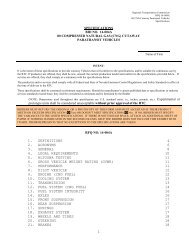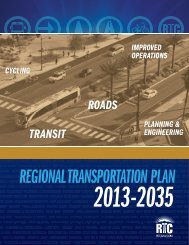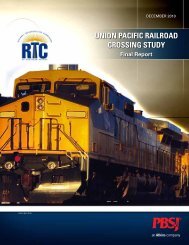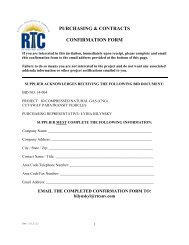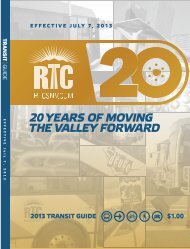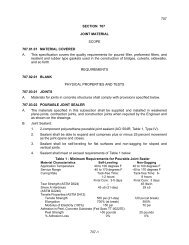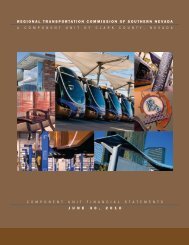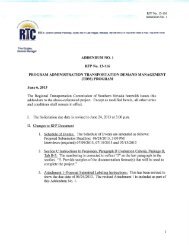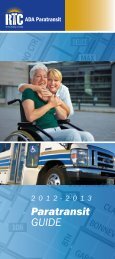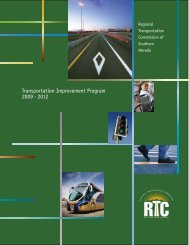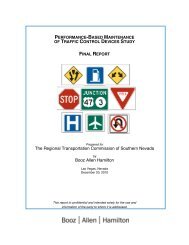(Blue Diamond Road) Corridor Study - Regional Transportation ...
(Blue Diamond Road) Corridor Study - Regional Transportation ...
(Blue Diamond Road) Corridor Study - Regional Transportation ...
You also want an ePaper? Increase the reach of your titles
YUMPU automatically turns print PDFs into web optimized ePapers that Google loves.
3. Overview of Transit Modes RTC SR-160 <strong>Corridor</strong> <strong>Study</strong><br />
EXHIBIT 3-3: Conventional Bus Transit Capital Costs<br />
Capital Cost per Unit<br />
Stations<br />
Simple Stop $15,000 - $20,000 Station / Shelter<br />
Enhanced Stop $25,000 - $35,000 Station / Shelter<br />
Vehicles<br />
Vehicle Type<br />
Conventional Standard (40-foot) $300,000 to $350,000 Vehicle<br />
Conventional Articulated (60-foot) $500,000 to $645,000 Vehicle<br />
Propulsion System<br />
Trolley, Dual Mode +$200 to $400K increment Vehicle<br />
Hybrid Electric $100 to $250K increment Vehicle<br />
Fare Collection<br />
Electronic Farebox $4,000 to $12,000 Farebox<br />
Electronic Farebox with Smart Card Reader $5,000 to $14,000 Unit<br />
ITS<br />
Vehicle Prioritization – Signal Controller Hardware $4,000 to $10,000 Intersection<br />
Operations Mgmt. – Vehicle Location System $5,000 to $35,000 Vehicle<br />
Unit<br />
3.2 BUS RAPID TRANSIT<br />
3.2.1 Overview<br />
Bus rapid transit (BRT) represents an improvement upon conventional bus transit. RTC’s<br />
MAX system is one form of BRT. What differentiates BRT from conventional forms of bus<br />
transit is that BRT represents a fully integrated system designed to achieve higher<br />
performance. More specifically, BRT is an integrated system of physical elements and<br />
infrastructure, service design elements, and customer interface elements to provide a<br />
flexible, high-performance rapid transit mode with a unified quality image and a unique<br />
identity. The high level of design granted to bus rapid transit systems allows them to<br />
achieve many of the same performance objectives and benefits that some rail systems do.<br />
BRT systems have evolved as more attention has been paid to improving the performance<br />
of conventional bus services. Bus rapid transit systems have been in development all<br />
around the world with applications in Asia, Australia, Europe, and North and South America.<br />
In response to these developments, transit agencies in the United States are learning from<br />
the best examples around the world to develop BRT systems of their own. So far, at least<br />
10 regions in the United States have completed BRT systems and many more are under<br />
development. The RTC in Las Vegas has implemented MAX, one of the most technologically<br />
advanced BRT systems, in the North Las Vegas Boulevard corridor heading in a<br />
northeasterly direction from the Downtown Transit Center (DTC).<br />
3-6



